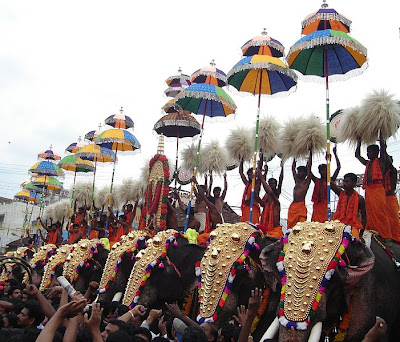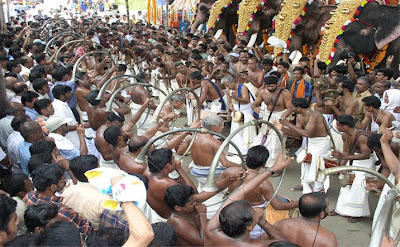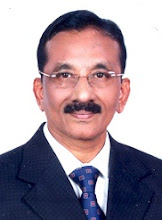Thrissur Pooram - Overview
Thrissur Pooram is called 'the pooram of all poorams'. It the biggest or the best of all poorams. The Thrissur pooram, is celebrated every year, on the pooram day, in the month of Medam (mid-April to mid-may) month as per the malayalam calendar. While all poorams have a huge influence on surrounding neighborhoods and towns, few other festivals require their active involvement. Thrissur town plays host, for 36 hours from the wee hours of the pooram day, to one of the most largest collection of people and elephants. The richly decorated elephant, as seen during the Thrissur pooram, is now globally recognized, and its association with Kerala. On the pooram day, fifty (50) or more elephants pass through the very center of Thrissur town, the Vadakkunnathan temple. The main features of the pooram festival are these decorated elephants with their nettipattam (decorative headdress), beautiful craftedthe kolam, decorative bells and ornaments etc. Add to this the panchavadyam, the rhythmic beating of the drum, and what would be a cacophony otherwise is turned into an organized but spontaneous symphony. The fireworks display in the early hours of the next day, rival shows held anywhere in the world, without even using many of the modern and newer pyrotechnics.
Thrissur Pooram 2010 date is April 24. The Trichur Puram festival, referred as the Mother of all Poorams, is annually observed in the Malayalam month of Medam (April – May).
 Thrissur Pooram is celebrated at of the Vadakkunnathan Temple, situated on a hillock (Thekkinkadu maidan) in the centre of the city, on the Pooram day in the month of Medom (April-May). Processions of richly caparisoned elephants accompanied by percussion ensembles from various neighbouring temples culminate at the Vadakumnathan temple. The most impressive processions are those Thriuvambadi Bhagavathy from the Thiruvambadi Sri Krishna Temple and the Paramekkavu Bhagavathi from Paramekkavu temple. The celebrations which last for over 36 hours includes parasol displays and firework shows.
Thrissur Pooram is celebrated at of the Vadakkunnathan Temple, situated on a hillock (Thekkinkadu maidan) in the centre of the city, on the Pooram day in the month of Medom (April-May). Processions of richly caparisoned elephants accompanied by percussion ensembles from various neighbouring temples culminate at the Vadakumnathan temple. The most impressive processions are those Thriuvambadi Bhagavathy from the Thiruvambadi Sri Krishna Temple and the Paramekkavu Bhagavathi from Paramekkavu temple. The celebrations which last for over 36 hours includes parasol displays and firework shows.Vadakkunnathan is a mere spectator at this festival, lending its premises and grounds for the great event. The pooram festival is also well known for the magnificent display of fireworks. Fire works start in the early hours and the dazzling display last three to four hours.
 The Pooram Festival is celebrated by two rival groups representing the two divisions of Thrissur Paramekkavu and Thiruvambadi vying with each other in making the display of fireworks grander and more colourful. Each group is allowed to display a maximum of fifteen elephants and all efforts are made by each party to secure the best elephants in South India and the most artistic and colourful parasols, which are raised on the elephants during the display. Commencing in the early hours of the morning, the celebrations last till the break of dawn, the next day.
The Pooram Festival is celebrated by two rival groups representing the two divisions of Thrissur Paramekkavu and Thiruvambadi vying with each other in making the display of fireworks grander and more colourful. Each group is allowed to display a maximum of fifteen elephants and all efforts are made by each party to secure the best elephants in South India and the most artistic and colourful parasols, which are raised on the elephants during the display. Commencing in the early hours of the morning, the celebrations last till the break of dawn, the next day.The marvellous as well as magical effect of the Panchavadyam, a combination of five percussion and wind instruments is to be felt and enjoyed. Among the varieties of festivals celebrated in Kerala, Thrissur Pooram is the most thunderous, spectacular and dazzling. There are three temples participating in the event. It is an expression of popular fascination for sound and colour, and because of the pageantry, it appeals to all people. The images of the deities from all temples of the village are taken on elephants to the main temple. The climax of the festival is the exhibition of thirty elephants and the famous fireworks at 2.30 am local time.
Paramekkavu Bagavathi Temple gateAdhering to the medieval Peruvanam tradition, the festival is confined to the temples of Devi (goddess) and Sastha (divine combination of Shiva and Vishnu). Ten deities from the neighboring temples pay obeisance to the presiding deiety of Thrissur.
 Principle participants are Paramekkavu and Tiruvambadi, close to the Vadakunnathan temple. Also participating and known as constituent Poorams are the suburban temples at Kanimangalam, Karamukku-Chiyyaram, Choorakkattukara-Amala, Laloor, Ayyanthole, Neithilakkavu-Kuttoor, Chembukkavu and Panamukkampilly-Eastfort Thrissur for a total of eight deities. The sprawling Thekkinkadu maidan, encircling the Vadakumnathan temple, is the main venue of the festival .
Principle participants are Paramekkavu and Tiruvambadi, close to the Vadakunnathan temple. Also participating and known as constituent Poorams are the suburban temples at Kanimangalam, Karamukku-Chiyyaram, Choorakkattukara-Amala, Laloor, Ayyanthole, Neithilakkavu-Kuttoor, Chembukkavu and Panamukkampilly-Eastfort Thrissur for a total of eight deities. The sprawling Thekkinkadu maidan, encircling the Vadakumnathan temple, is the main venue of the festival .

























